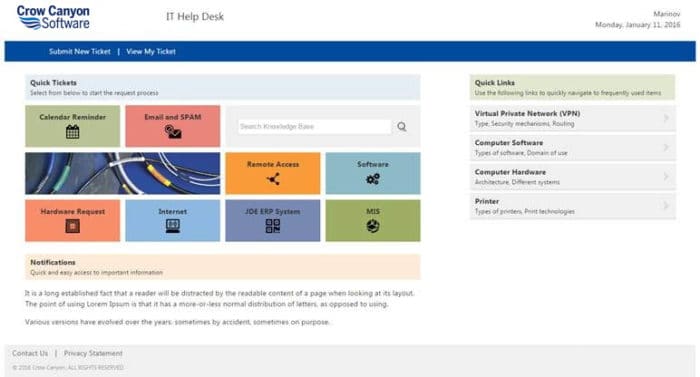 One way our applications boost the power of SharePoint and Office 365 is through the use of Application Portals. These Application Portals give users ways to engage effectively with our applications, thereby driving user adoption and accelerating usage of SharePoint and Office 365.
One way our applications boost the power of SharePoint and Office 365 is through the use of Application Portals. These Application Portals give users ways to engage effectively with our applications, thereby driving user adoption and accelerating usage of SharePoint and Office 365.
Application Portals differ from Intranets, Team Sites, and Comm Sites in that they are focused on the end user’s interaction with our applications. This means giving users the ability to create a request, view pending requests, search a knowledge base, browse a service catalog, see announcements, and other application-related functions.
One concise way to describe an Application Portal is: “an engaging dashboard interface that acts as a gateway to application functionality”. Application Portals offer a significant degree of flexibility in terms of configuration, security, user experience, and role-based access. They give administrators an unprecedented level of control when it comes to crafting an engaging and friendly environment for specific groups of users or customers.
Let’s have a closer look at Application Portals from the user and administrator perspectives.
Application Portals from the User Perspective
Application Portals offer employees a number of usability advantages that help organizations facilitate solution engagement. Some of the key benefits of Application Portals are:
• Friendly and Intuitive: Application Portals feature all the necessary functions for users to engage with an application without forcing them to use backend SharePoint interfaces. Our implementations are highly configurable, so Application Portals can be customized to reflect a company’s branding. Users need to enjoy using a product — well-balanced UI/UX and intuitive functionality means that employees will look forward to using an Application Portal without facing the complexities of the native SharePoint screens.
• Mobile-ready: Being able to access business platforms while on-the-go is imperative, and the responsive coding of Application Portals support a fully device-agnostic experience. Whether using a tablet, smartphone, or a laptop, the portal dashboard will always be accessible while meeting functional requirements.
• Simple and Relevant: Simplicity is the key to releasing multiple iterations of an Application Portal. The idea is to present an easy-to-use interface that is intuitive and includes functionality relevant to the user logged on. For example, a Support Technician using the Crow Canyon IT Help Desk would be able to create, view, and edit tickets while a Manager would have the additional capability to build reports for analysis. Both environments are simple to use while also being highly relevant to the logged-on user.
Example of an End User Application Portal

Application Portals from the Administrative Perspective
Administrators responsible for implementing Application Portals enjoy the freedom and configurability that they offer. Key benefits of Application Portals for administrators include:
• Backend Isolation: Application Portals provide self-contained environments for users who need to interact with SharePoint-integrated applications, but who are not required to become SharePoint proficient. SharePoint, and all of its integrated functionality, can be intimidating for some users — particularly those without a technical background.
In addition, some employee groups may simply not require access to full SharePoint functionality. For example, a first-level Support Technician or an HR Onboarding Specialist would not need to create new list templates or edit database connections. Their interactions with SharePoint, and integrated business platforms such as Crow Canyon Software products, are fairly narrow. Application Portals give admins the ability to align access to required functionality with user role.
• Design Flexibility: Application Portals are Web-based and their appearance —functionally and aesthetically — can be easily configured by simply changing settings as needed. Sections can be added or removed and the look and feel can likewise be modified. Companies have the freedom to build out multiple Application Portal versions based on need, whether that be user-role, location-based, departmental, or otherwise.
• Easy Sharing: Since Application Portals are Web-based, sharing is simply a matter of providing a secure link to a recipient. The backend system automatically determines permissions based on the logged-in user and then presents the correct interface. For example, a Manager could share the URL of a list of open tickets with an employee. After logging on, the employee would only see those tickets that he or she is permitted to see.
Sharing can also include allowing customers access to their own Application Portal. This is a way to deepen engagement with customers when doing support and service. The Crow Canyon Customer Support program can include this capability so that customers, clients, members, etc., can directly engage with the support system and create and view their own requests.
• Intranet Integration: Application Portals can easily integrate with the company Intranet. A link can be provided on the Intranet home page that takes the user to the Application Portal. Alternatively, the Intranet link could directly open the request form or the list of submitted tickets. In any of these cases, the user is presented with pages that resemble the Intranet but are actually part of the Application Portal, thereby allowing them to submit and view requests or issues – whether IT, HR, Facilities, or other types – directly from the Intranet. This extends an Intranet so that it includes much more business functionality than simply displaying company news and events.
Conclusion
Application Portals differ from their SharePoint cousins (Team Sites and Comm Sites) in their inherent flexibility. Multiple iterations based on user role, highly configurable UI/UX, and a simple easy-to-use interface enable organizations to foster employee productivity while maintaining control over their functional access. While Team Sites and Comm Sites take a one-size-fits-all approach, Application Portals have the capability to be highly relevant to users and/or customers, while being widely adaptable to user needs and preferences.
—
Crow Canyon’s business applications, powered by our unique NITRO™ platform, boost the native power of SharePoint and Office 365. Our built-in Application Portals leverage this power by putting you in control of your employees’ experiences.
Want to learn about how our business productivity applications for SharePoint and Office 365 can power up your organization? Give us a call at 1-925-478-3110 or contact us by e-mail at sales@crowcanyon.com. We look forward to hearing from you!

